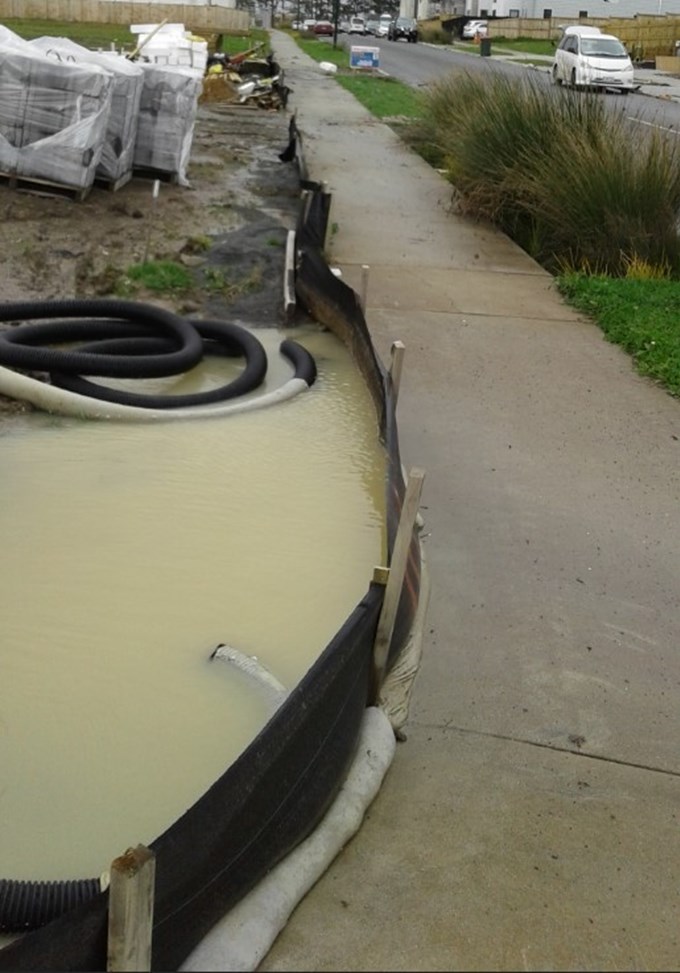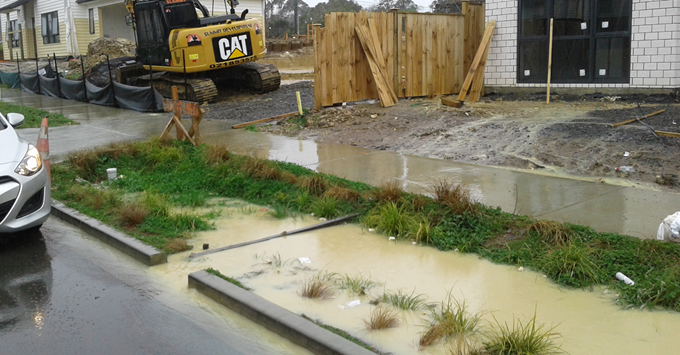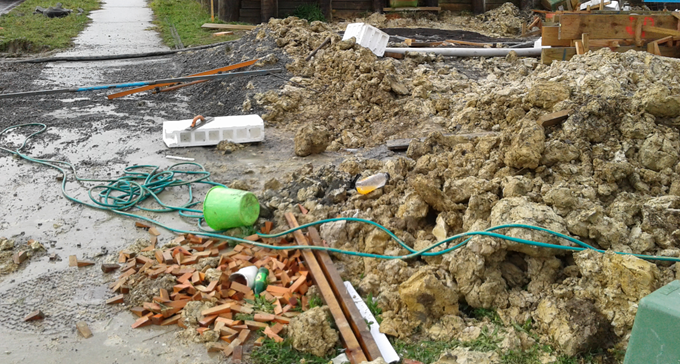Auckland Council’s commitment to take action against a widespread lack of sediment controls on building sites is progressing well. Two full-time compliance officers have been inspecting small residential construction sites across the region to ensure adequate sediment controls are in place from the very first cut of earth.
Small sites account for around 600 hectares of land disturbance per year, while medium and large sites total around 480 hectares annually. Small sites are the bulk of land-disturbing activity with around 13,500 small sites developed annually across Auckland.
The council’s action builds on last year’s education and compliance campaign at large subdivisions across Auckland and addresses a specific gap in compliance monitoring between the sign-off of bulk earthworks and the start of work on smaller sites.
Mayor Phil Goff says that with the surge in building around the city, the need to take steps to protect the environment and stop sediment running into our streams and harbours is vital.
“Old practices around building sites where the run-off of material into drains and streams was ignored are no longer good enough. Protecting our environment has to be central to building best-practices and action will be taken against those who disregard the rules and damage our waterways,” says Mr Goff.
Councillor Penny Hulse, chair of the council’s Environment and Community Committee stresses that while the council encourages development to meet the current housing shortage, it cannot be at the expense of the environment.
“Without appropriate controls, sediment run-off could pollute Auckland’s waterways and harbours and pose a risk to the public, the environment and wildlife. The potential of this issue to impact negatively on the region’s waterways has increased over the past decade with rapid intensification of housing development across the region,” says Councillor Hulse.
Councillor Hulse says that small sites have historically had low levels of compliance in both sediment control and broader environmental performance. The council’s Strategic Approach to Sediment programme identified that work was needed to put in place a robust, regional-scale end-to-end monitoring procedure to complement existing targeted enforcement and education.
“We know that monitoring compliance of ‘permitted activities’, which describes most small developments in Auckland, is problematic for most councils. However, the scale and intensity of Auckland’s growth means that we needed an innovative regional response. Our response is the council’s ‘close the gap’ initiative,” explains Councillor Hulse.
The council’s Strategic Approach to Sediment programme identified a need to introduce interventions at multiple levels to reduce sediment to waterways. To help target interventions appropriately, sites were categorised at small, medium and large to reflect the size and scale of development and associated earthworks. These thresholds trigger different regulatory processes.
As can be seen below, the cumulative impact of Auckland’s growth means that over half of our disturbed land by area is likely to involve small construction sites.
Site sizes and relative land disturbance area both per site and cumulatively

‘Close the Gap’ initiative
"I believe that the council’s initiative in trying to improve sediment control on building sites across the region will have benefits that will extend far beyond what we can see and quantify now for ourselves and will greatly benefit our next generation and beyond that will inhabit the region.” Mr Allan Moore, General Manager of Signature Homes Botany
The council’s ‘Close the Gap’ initiative is running for the winter works season from May to August 2019. Funded jointly by council’s strategy, operations and regulatory departments, it aims to establish cost-effective mechanisms to ensure sediment controls are in place on all small sites prior to any land disturbance activity, i.e. closing the gap from when bulk earthworks are signed off and the first building inspection of the foundations.
‘Close the Gap’ actions include:
- Two full-time dedicated compliance officers visiting the 800 - 1,000 small sites that start each month.
- Seeking to provide evidence of the extent of non-compliance and requiring the installation of appropriate erosion and sediment controls prior to ‘first cut’ (before development begins)
- Examining how we can improve internal notification that development is about to begin
- Investigating the administrative implications of introducing a mandatory pre-start sediment control inspection
- Assessing options for a self-certification process if the erosion and sediment control devices are installed by an approved ‘installer’.
Howick, Upper Harbour and Hibiscus and Bays Local Boards recently confirmed funding of ‘end of pipe’ monitoring for sediment on selected small site subdivisions within their local board areas. These results will provide early indication of the need for increased enforcement action. The council has also run compliance campaigns, presented 12 ‘Tool Box Talks’ with developers and conducted two Small Building Sites Demo events attended by builders and contractors.
To support enforcement action, the Licensing and Regulatory Compliance Targeted Initiatives team will also:
- Train the council’s 120 Building Inspectors to notify the absence, presence and/or adequacy of appropriate erosion and sediment controls at inspections up to and including the ‘post-line’ inspections (from August 2019)
- Include displays of sediment control techniques relevant to small sites at the Annual Sediment Field Day
- Run a series of industry workshops like Tool Box Talks with developers and the Master Builders’ Federation
- Explore innovative use of satellite imagery to indicate changing land use (to assist with targeted monitoring and enforcement).
Working with the industry
Visits to almost 1000 small sites during May and June 2019 showed high levels of non-compliance, with 88 per cent of the small sites that had started works having either no sediment controls or inappropriate sediment controls in place. The 12 per cent of sites that did have adequate controls were sent a letter informing owners that their compliance was noted and appreciated. On the small number of sites where works had not yet started, a letter was sent advising them of their obligations under the Auckland Unitary Plan to meet the appropriate performance standards for erosion and sediment control.
Councillor Linda Cooper, chair of the council’s Regulatory Committee, says that building companies must understand that being a ’permitted activity’ status, does not mean anything goes on a site.
“We encourage everyone who is developing a site to take responsibility for controlling sediment run-off on their site,” says Councillor Cooper.
“And we do have examples of companies like Signature Homes working closely with us to improve their performance, not just because it is a regulatory requirement, but because they believe it is the right thing to do.”
Allan Moore, General Manager of Signature Homes Botany, believes that improving sediment control on their residential sites is important to the company and reflects their commitment to managing construction waste in a responsible way.
“Like most Aucklanders, we do not want to see sediment or material from construction sites flow into drains and end up in the ocean. We are pleased to be working with Auckland Council to continually improve our practices and implement strong sediment control policies,” says Mr Moore.
“Signature Homes is supportive of any positive action initiated by the council to improve trade practices aimed at protecting the environment in which we all must live. It’s great to see the council working with us to improve things and we are only too pleased to assist in any way can to get the message out to contractors that bad practices will not be tolerated and continued use of them will result in disciplinary action,” Mr Moore says.
Early results?
A willingness to ‘do the right thing’ appears to be gathering momentum as site owners realise that the council is serious about its approach to sediment. Anecdotally, staff are already seeing improvements on some subdivisions, with sediment fences appearing where previously there were none. Staff are also starting to receive phone calls from site owners asking for advice on how to install appropriate sediment controls for their sites in response to their neighbours facing enforcement action or receiving a congratulations letter.
What else are we planning to do to?
The council’s Strategic Approach to Sediment programme is about developing regional scale interventions to drive a reversal of the environmental decline caused by sediment runoff into Auckland’s streams, rivers, lakes and coastal waters. To reflect community and political concerns, the first phase of the programme has focused on sediment generated by land development, particularly from small sites.
The next phase will work on interventions to improve performance on medium and large sites, as well as scoping approaches to other sediment sources. This will complement and enhance the council’s many activities to improve sediment outcomes for the region.
Councillor Hulse reminds Aucklanders that sediment is one of the key pollutants of our freshwater and receiving estuarine and marine environments leading to a deterioration in water quality, loss of habitat and degraded aquatic ecosystem health.
“Excess sedimentation of our waterways is a major issue for the whole of New Zealand,” she says.
“It is a complex issue to resolve as there are many sources of sediment and causes of sedimentation, but we are committed to continue working with a broad range of stakeholders to improve sediment controls throughout Auckland.”
Our next steps
The next steps for the programme include:
- Developing options for industry environmental training requirements
- Develop case studies to assess the effectiveness of sediment controls under different conditions
- Develop and encourage the use of transparent, consistent guidance
- Advocate for national-level industry qualifications and accreditations
- Run a series of industry workshops to encourage and enable voluntary compliance on medium-sized construction sites
- Further develop partnerships with community and mana whenua
A final word
As a representative of the industry, Mr Moore has a word of advice for people working to develop small sites.
“We think it is the responsibility of everyone involved in the building process to ensure sites manage their sediment. The council is working hard to improve compliance, but we believe that there should be more people actively implementing sediment control because it is the right and responsible thing to do, not solely because it is a requirement.
“We acknowledge that our sites are our best advertisement and if we want to be successful and grow our business, we must be seen to be proactive in preventing what we do on-site adversely affecting others. Being aware of how the lack of sediment control can affect others and the environment has reinforced to us how important it is to implement effective controls on site.”
For more information on building site management, check out the council's website.




